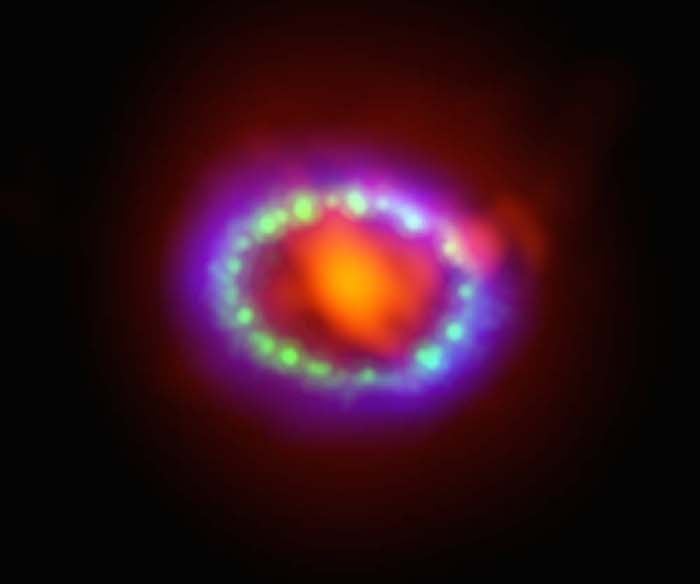,

This image shows the remnant of Supernova 1987A seen in light of very different wavelengths. Data (in red) show newly formed dust in the center of the remnant. Data in green and blue show where the expanding shock wave is colliding with a ring of material around the supernova. This ring was initially lit up by the ultraviolet flash from the original explosion, but over the past few years the ring material has brightened considerably as it collides with the expanding shockwave. Credit: ALMA (ESO/NAOJ/NRAO)/A. Angelich/Hubble Space Telescope/Chandra X-Ray Observatory
.
New results from the NASA NuSTAR (link is external) telescope show that a supernova close to our galaxy experienced a single-sided explosion.
A team of scientists including Lawrence Livermore National Laboratory researchers found that X-ray emissions taken with the Nuclear Spectroscopic Telescope Array (NuSTAR) show that the Supernova 1987A explosion was highly asymmetric. The results appear in the May 8 edition of the journal, Science.
NuSTAR observations, including those of 1987A, provide strong and compelling observational evidence that supernovae are not symmetric.
Supernova 1987A in the Large Magellanic Cloud provides a unique opportunity to study a nearby (170,000 light years) core collapse supernova explosion (CCSN) and its subsequent evolution into a supernova remnant.
SN1987A has validated some basic scientific assumptions about CCSNs. A neutrino flash confirmed that the overall explosion is driven by the collapse of the central core to a neutron star. Direct gamma-ray detection of cobalt isotopes and the correlation between the exponential decay of the optical light curve and lifetime of these isotopes confirmed that the light curve is powered by radioactive decay.
“Even with all we have previously learned about SN1987A, NuSTAR has taught us some new things,” said Michael Pivovaroff, one of the LLNL scientists and co-author of the paper. “Our observations confirmed the tremendous speeds at which the exploding material is moving and helped us constrain geometrical models that show just how lopsided the supernova explosion was.”
In core-collapse supernovae, an isotope of titanium (⁴⁴ Ti) is produced in the innermost ejecta, in the layer of material directly on top of the newly formed remnant. The radioactive decay of this isotope provides a direct probe of the supernova engine. NuSTAR measurements confirm that heavy elements are moving at speeds of about 3,000 kilometers per second, several times higher than expected from spherically symmetric models.
There has been growing evidence for asymmetries in supernovae explosions over the past decades, including in SN1987A from the extensive evidence for mixing and polarized optical emission. NuSTAR observations of the spatial distribution of ⁴⁴ Ti in the Cassiopeia A supernova remnant show direct evidence of asymmetry. These observations indicate even more asymmetry for SN1987A.
Subsequent X-ray observations have revealed expanding, brightening ejecta (a supernova remnant). To date, there is no evidence yet for a compact central object that formed the core of the exploding star.
NuSTAR observed SN1987A for multiple periods between September 2012 and July 2014 with a total exposure of 2,283 kiloseconds (a kilosecond is 1,000 seconds).
NuSTAR, a NASA Explorer-class mission launched in June 2012, is uniquely designed to detect the highest-energy X-ray light in great detail. For Livermore, the predecessor to NuSTAR was a balloon-borne instrument known as HEFT (the High Energy Focusing Telescope) that was funded, in part, by a Laboratory Directed Research and Development investment beginning in 2001. NuSTAR takes HEFT's X-ray focusing abilities and sends them beyond Earth's atmosphere on a satellite. The optics principles and the fabrication approach for NuSTAR are based on those developed under the HEFT project.
The Lab’s contribution to NuSTAR has been recognized by NASA in recent awards. Pivovaroff and LLNL physicist Julia Vogel are part of the NuSTAR science team that received a group award in September 2014 “for exceptional achievement in executing the NuSTAR science program leading to groundbreaking discoveries in high energy astrophysics.” They, along with Lab engineer Todd Decker and postdoc Nicolai Brejnholt, also were part of the NuSTAR instrument team that received a group award in July 2013 “for outstanding performance in the design and successful implementation of the first space-borne high energy X-ray focusing telescope.”
Other collaborators on this Science publication include University of California, Berkeley, California Institute of Technology, Los Alamos National Laboratory, North Carolina State University, McGill University, Universite de Toulouse, CNRS, Technical University of Denmark, Agenzia Spaziale Italiana, Columbia University, RIKEN, SLAC National Accelerator Laboratory, Osservatorio Astronomico di Roma, Jet Propulsion Laboratory and NASA Goddard Space Flight Center.
Quelle: Lawrence Livermore National Laboratory ,7000 East Avenue • Livermore, CA 94550
5438 Views
